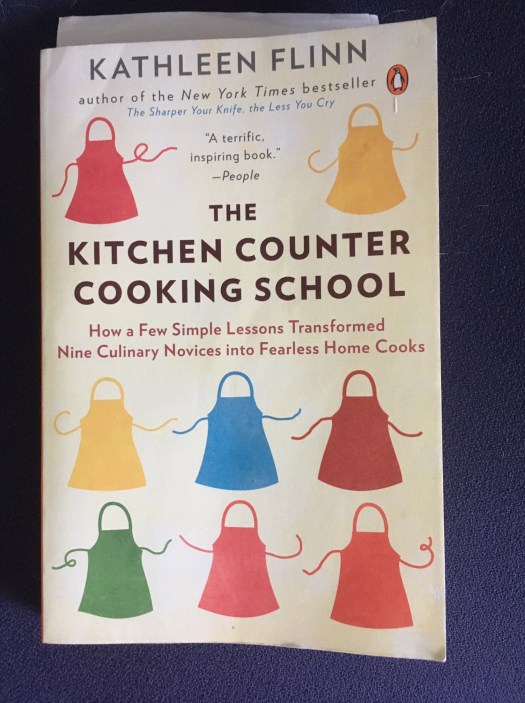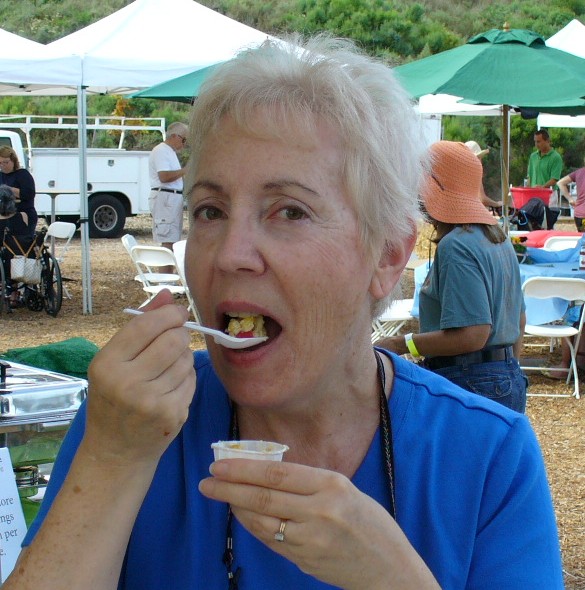
My well-thumbed copy of “The Kitchen Counter Cooking School” by Kathleen Flinn is my recommended reading to you for 2019. (Photo by Laura Groch)
If you’re one of the millions who are resolving to change your eating/cooking/food-buying habits in the new year, have I got a recommendation for you. I have meant to write about this book forever, but I just keep rereading it and re-enjoying it for myself. (And procrastinating too, yes.)
But no more. My 2019 resolution is to share this book with you, so: “The Kitchen Counter Cooking School: How a Few Simple Lessons Transformed Nine Culinary Novices Into Fearless Home Cooks,” by Kathleen Flinn (Penguin Books, 2011).
Here’s the premise. Flinn was in the supermarket one day when she saw a woman whose cart was filled with processed and pre-made foods. She took a chance, chatted up the shopper, and realized she simply didn’t know how to cook. Flinn showed her a few easy ideas that would let her prepare meals that were more healthful and less expensive than what she’d been buying.
Thus “The Kitchen Counter Cooking School” was born. Flinn, a trained chef, knew this woman wasn’t alone. So she put out a call for people who wanted to learn how to cook, or how to cook better. She got nine takers — all women (one man dropped out) — who had various kitchen issues. Some lacked confidence. Some had no training from their moms (who at that time were still the main chefs of most families). Some had unsupportive spouses (yes, control can be a thing). All knew how to do a few dishes, but most of their repertoire was defrosting frozen meals or using processed (fatty, salty) foods to prepare meals.
They had good intentions — bought fresh vegetables and meats — but then lost their nerve in the kitchen and ended up tossing out unused and by-then spoiled food.
Flinn took the women to a commercial kitchen and taught them basic, simple skills over several weeks: How to chop vegetables and season them. How to cut up a chicken and prepare it simply. How to make salad dressing. How to cook pasta and make an easy sauce. How to use leftovers in omelets or salads. How to buy food and not let it go to waste week after week.
“Kitchen Counter” is a fun read for cooks of all levels because it tells a story, although it also has recipes. The before-and-after profiles of the women and the changes they were able to make after Flinn’s no-stress, no-problems instruction are enlightening. Some made great strides and found that not only were they saving money, but losing weight and improving their health (less salt, less fat). Others achieved only modest changes, but still reaped benefits. They learned how to read labels, look for hidden sugars, use leftovers.
Along the way, Flinn drops all kinds of nutritional knowledge, but in such a low-key and easygoing way that you never feel preached to. She wants people to be more aware of what they’re eating and why — and more important, what’s in those boxes and how you can prepare the same foods yourself for a lot less money. (Check out the “What’s in the Box?” chapter, which discusses, among other things, cake mix.)
Flinn’s point is that you don’t have to be a kitchen expert to be able to feed yourself and your family well — and economically. With the basics outlined in this chatty, friendly book, I think everyone can find something to learn and/or improve for 2019.
I hope you’ll seek this book out and enjoy it as much as I have over the years. :<)
A lot of Flinn’s students knew how to cook vegetables (and yes, frozen packages are OK), but then didn’t know how to flavor them appetizingly. She showed them how to build what she calls “Flavor Splashes”: Mix these ingredient in a small saucepan, heat briefly, pour onto vegetables and toss to coat. Each recipe flavors about four side servings of vegetables.
ASIAN-GINGER LIME
Warm 2 teaspoons of sesame oil, then add 1 teaspoon of fresh grated ginger or a couple of pinches of dried ginger, a few squeezes of fresh lime juice, and 1/2 teaspoon of soy sauce. Heat through for about 3 minutes.
GARLIC CITRUS BUTTER
Heat2 tablespoons of butter, add 2 small cloves of minced garlic, a bit of fresh thyme or mixed dried herbs, and 1 teaspoon of lemon or orange juice, and saute for a couple of minutes, until the garlic softens.
CAJUN OIL
Warm 2 teaspoons of olive oil, add 3 finely chopped green onions, and cook until tender, then add 1 teaspoon of Cajun spice blend, a few squeezes of fresh lemon juice, and a couple of drops of hot sauce.
(c) copyright 2019 Laura Groch
